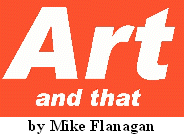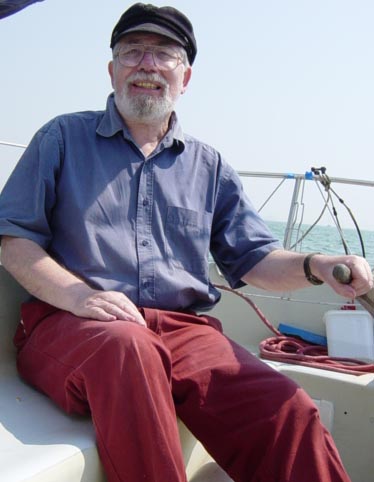|
On that tenth time you have painted a watercolour! Many amateurs choose watercolour because they see it as coloured illustration. That is indeed one way of doing it, but it is not the best way. Always paint the lightest parts of the picture first. You can then cover it over with the darks. Remember that when a watercolour dries it will be lighter than when you painted it, so paint darker than you need to. Try not to mix more than two colours out of the tube or box. More than three colours and you start to get mud. MF: Oh yes, you make it sound magical. Are there any artists that you admire? CJ: I have always loved Velasquez's work and Leonardo. Among more recent artists, I like Hockney and Augustus John and for watercolours John Blockley and John Yardley. MF: When did you first discover you were good at making art? Also, can you draw me a time line of how your art interests developed? CJ: As soon as I could hold a pencil or brush I was trying out drawing and painting. My earliest memory was in my Infants school in Gloucestershire in the 1940s. We |
|||||||||||||||

|
school in Canterbury, I spent a lot of time in the art room because I loved the smell of the oil paints. I sold my very first drawing at the age of about 15 to another boy at school called Edward Lucie -Smith. He eventually became a very well-known art critic and writer. I wanted to go to Art school, but my parents wouldn't hear of it. In the end I went into the Navy. I carried on painting in oils and watercolours throughout my service and used to teach painting and calligraphy classes on board the various aircraft carriers. I made murals on the walls of the gun room in HMS Bulwark and helped to edit and illustrate shipboard magazines. When I left the Navy I went to King Alfreds College for Teacher Training and took main Art and English. I also signed on part time at the Winchester School of Art at the same time as I felt so starved of proper training. I left college with a distinction in Art and Education. The next few years were taken up with Primary teaching , but using a lot of art as a means to learning. I was appointed as a tutor in Art and Education at the Leicester College of Education in 1966. It was not until I retired from Teaching in |
||||||||||||||
|
a heart attack last week, so she took pity on him and put a straw hat on. MF: I like your watercolour nudes, but what is it about painting the human form that's so important. What's wrong with a bowl of fruit? CJ: Nothing wrong with a bowl of fruit. I have painted many a light meal in the past, but that was before I could afford a human model. When I was a student, the craft of life drawing in the sixties almost fell into disrepute. Art Schools were more concerned with originality than skill. I am glad to say that both are now respected in most seats of learning. Drawing and painting the female nude, is not just a fun thing to do, but truly presents a challenge as great as any landscape or still life. The slightest error shows up even to the non-artist, because even the untrained eye knows what and where muscles and bones should be. If after becoming fairly expert at the figure, you can then add some originality and style on top then you begin to have great art. The difficulty is in moving from an accurate representation to a painting or drawing with what I would call 'Added Value' Many artists never move on from that, but we try our best. A good model, who knows how to pose and who can help the artist is a rare bird, and worth her weight in lead pencils if you can find one. A model is alive and kicking. A bowl of fruit just gets more and more rotten as you watch it! MF: Will you tell me about the technique of watercolour. Like a mini masterclass in a few sentences. CJ: The main thing to remember about watercolour is that you must be prepared to accept happy accidents. True watercolour painting is not an exact science and it thrives on the artist not worrying too much about exactness. You may draw an accurate drawing but as soon as you apply watercolours, it is best to allow the water and the paint to take over. Spread wet colour across the paper and then drop more paint on top of it. It is almost the exact opposite of oil painting. With oils you are in control. With watercolour you splosh paint on and hope something wonderful will happen. Nine time out of ten nothing does. |
|||||||||||||||
| Artist Christopher Jarman tells me about life and life drawing. | |||||||||||||||

|
|||||||||||||||
|
I got that wow feeling the moment I approached his big, pretty home in Winchester. Early evening and already the huge gravel drive was strewn with Jags and Beamers. I had to hide my pathetic car behind a banyan tree. The bloke who answered the door could easily have been the butler except he had the twinkly eyes and tombstone grin I'd seen on his photo earlier. 'Come in, old fruit', he barked in a Terry Thomas voice, 'we'll talk in my study.' On the way there I glanced into the room where all the action was. Six elderly geezers sitting in a circle, surrounding a pretty young naked model draped all over the show. It was like Country Life meets the Pre-Raphaelites. Later we sat in his study sipping lethal black coffee and started talking. MF: These life drawing groups of yours at home, how did they start and have the police been round? CJ: Ha ha, I daresay the police would love to come and draw our model, but I guess they're too busy guarding the homes of local bigwigs. A couple of us started hiring our own model at home here after the local life class fell apart. The tutor died and the temporary lecturers were not as well qualified as the students. The models they got hold of were either very weird men, or women the size of dump trucks. One of our older chaps nearly had |
|||||||||||||||

|
|||||||||||||||
|
each had a drawing book with black sugar paper pages interleaved with tissue paper. Very posh really. We were encouraged to draw with coloured pastels in this. Later I recall painting a watercolour frieze at home about six feet long and a foot high covered with my favourite Walt Disney characters. During the war I used to draw my family's portraits using old ledgers and blank books that my father brought home from work. I also drew cartoons about Hitler and the shortages of coal and food. I was always good at art in school and when I went to boarding |
|||||||||||||||
|
1989 however, that I took up watercolour painting almost full-time. I remember painting a thousand in that first year. I threw most of them away but sold a few in local London galleries. In 1995 or thereabouts I discovered computers and the lure of what is called Vector Graphics. MF: In a word what do you look for in an artist yourself? CJ: First, I look for skill, and then some spark of true originality or creativity. Art is essentially 'artifice' to be good takes skill and practice. |
|||||||||||||||